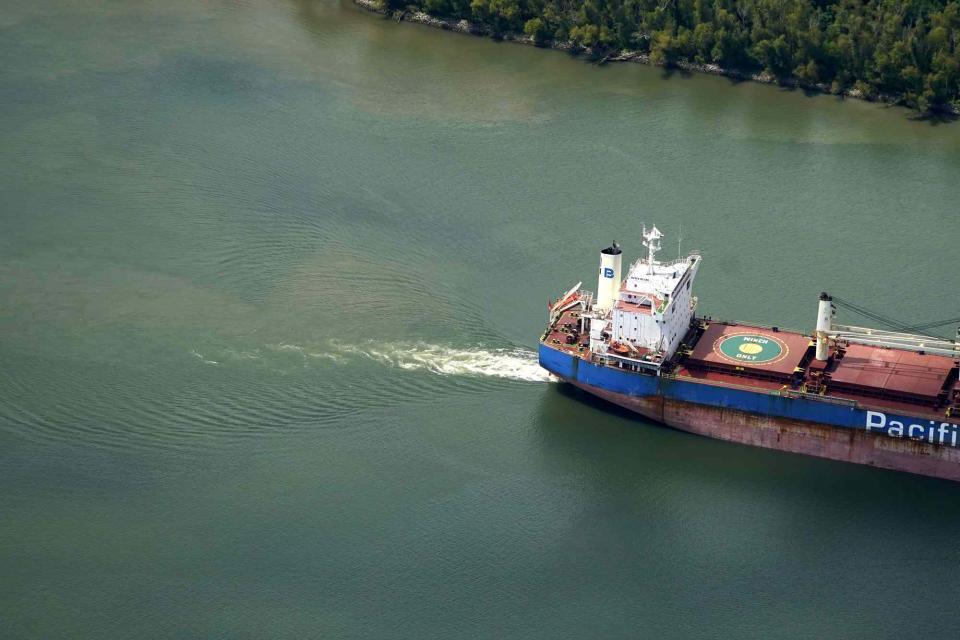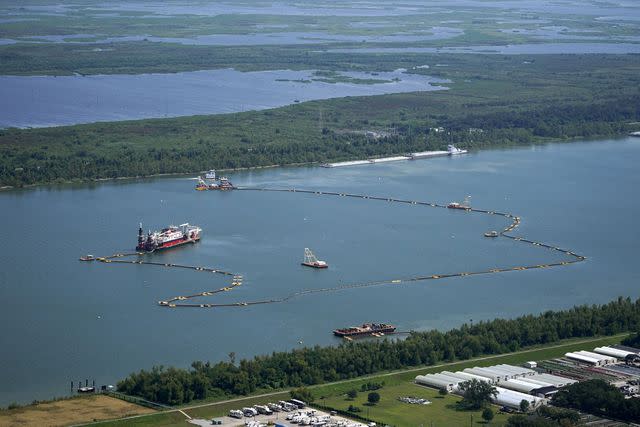New Orleans Faces Water Supply Crisis Over Salt — But 'This Is Not a Time to Panic,' Governor Warns
- Oops!Something went wrong.Please try again later.
The problem could make the water supply undrinkable until January, according to Collin Arnold, New Orleans' homeland security chief

Gerald Herbert/AP Photo
A tanker ship moves upriver in Plaquemines Parish, La., on Sept. 26 as sediment and mixed river water is visible.The worst of the saltwater intrusion for New Orleans is expected in late October and could threaten the city’s water supply for three month.
Based on projections from the U.S. Army Corps of Engineers, salt could make the water undrinkable until at least January, said Collin Arnold, New Orleans' homeland security chief, per NOLA.com.
According to a Sept. 25 news release from Louisiana Gov. John Bel Edwards' office, the saltwater intrusion has already affected Plaquemines Parish, while other parishes are expected to be impacted over the next month. Among them are St. Bernard Parish, Jefferson Parish and Orleans Parish.
In a typical year, the Mississippi River's volume of water flow is enough to prevent salt water from the Gulf of Mexico from intruding upstream into the Mississippi River above Head of Passes, according to the Army Corps of Engineers website.
But “when the river's flow falls below a certain level, salt water may begin to move upriver from the gulf," per the post. "The intrusion of salt water upstream into the Mississippi River is a naturally occurring periodic condition.”
Related: Louisiana Braces for Category 4 Hurricane as Ida Makes Landfall: 'A Life-Threatening Situation'
The governor’s office noted in its news release that “the rate of freshwater flowing down the Mississippi River has been low due to extended drought conditions in Louisiana and across the Mississippi River Valley.”
“Unfortunately, without any relief from the dry weather we are starting to see the saltwater intrusion creep further up the river despite efforts to mitigate the problems by the Army Corps of Engineers,” said Gov. Edwards on Sept. 22. “Our team at GOHSEP [ Governor's Office of Homeland Security & Emergency Preparedness] is working with all of our local, state and federal partners to determine what additional support will be needed and what steps can be taken to protect water systems and water intake points.
"Most importantly, this is not a time to panic or listen to misinformation. We have been through this situation before in 1988, and we are monitoring this situation very closely and applying the lessons learned. It is extremely important for the public to stay informed and only rely on credible sources for updates during this event.”
The Army Corps of Engineers said that because salt water has a greater density than fresh water, it moves upstream in the form of a wedge. They added that the upriver travel can affect municipal drinking water and industrial water supplies.

Gerald Herbert/AP Photo
This Sept. 26 news photo shows dredging operations to build an underwater sill in Plaquemines Parish, La.According to the Louisiana Department of Health, in addition to making the drinking water unsafe, saltwater intrusion poses a health risk, especially for people with kidney disease or high blood pressure, people on a low-sodium diet, dialysis patients, infants and pregnant women.
“The health effects of drinking saltwater have been found to be associated with cardiovascular diseases, diarrhea and abdominal pain,” the department added.
As of Friday afternoon, New Orleans’ drinking water is safe, according to a news release issued by the city.
“We have been and will remain in daily, close coordination with local, regional and state agencies to actively monitor the saltwater wedge moving up the Mississippi River and establish unified, collaborative efforts, strategies and public engagement,” New Orleans Mayor LaToya Cantrell said. “The most important thing for residents at this time is to stay informed and remain calm. As we continue monitoring this situation, we will communicate all necessary information to residents as it becomes available.”
Never miss a story — sign up for PEOPLE's free daily newsletter to stay up-to-date on the best of what PEOPLE has to offer, from celebrity news to compelling human interest stories.
In July, the Army Corps of Engineers built an underwater barrier sill to create an artificial basin to help delay the intrusion. However, said the governor’s office, the intrusion recently overtopped the sill’s existing elevation. The Wall Street Journal reported that the Corps is planning on extending the height of the sill by 25 feet.
Related: Louisiana Braces for Possible Hurricane After Floods Strike New Orleans: 'Water Was Everywhere'
Other mitigation efforts include reverse osmosis water purification units that can remove the salt water and produce fresh drinking water; a plan to distribute as much as 36 million gallons of fresh water daily via barges; and a proposal to construct a freshwater pipeline, the cost of which is estimated between $100 million and $250 million, Arnold said, per CNN.
Arnold also told NOLA.com that he hopes the construction of the pipeline will commence in about seven to 10 days.
Meanwhile, bottles of water have reportedly been quickly snapped up at stores, The New York Times reported. Joseph Zuppardo, an owner of a grocery store in a suburb northwest of New Orleans, told the paper that for a time they were selling about 2,000 bottles a day.
Related: 10 Hurricane Katrina Survivors Reveal Storm's Impact on Their Lives & New Orleans 15 Years Later
On Wednesday, President Joe Biden approved an emergency declaration in Louisiana in response to the saltwater intrusion. The action “authorizes the Department of Homeland Security, Federal Emergency Management Agency (FEMA), to coordinate all disaster relief efforts which have the purpose of alleviating the hardship and suffering caused by the emergency on the local population.”
“Efforts to mitigate the impact of the saltwater intrusion are currently underway and other projects are being considered based on the projections being received from the United States Army Corps of Engineers (USACE),” Bel Edwards said in a statement Wednesday in response to the president’s order. “This 90-day approval of our Emergency Declaration will help our state and local partners with the costs of any mitigation efforts and protective measures. As this event unfolds, we will continue to analyze the emergency efforts and impacts to determine if further requests will be necessary.”
For more People news, make sure to sign up for our newsletter!
Read the original article on People.

